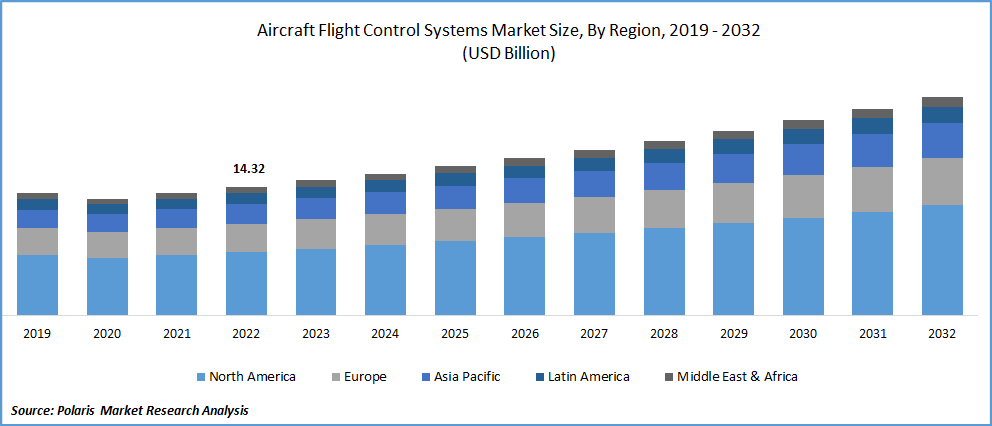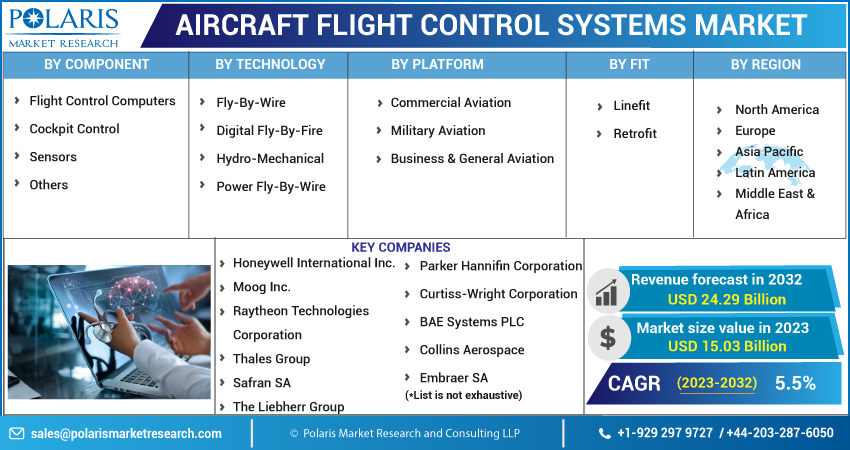
Aircraft Flight Control Systems Market Share, Size, Trends, Industry Analysis Report, By Component (Flight Control Computers, Cockpit Control, Sensors, and Others); By Technology; By Platform; By Fit; By Region; Segment Forecast, 2023 - 2032
- Published Date:Apr-2023
- Pages: 118
- Format: PDF
- Report ID: PM3119
- Base Year: 2022
- Historical Data: 2019-2021
Report Outlook
The global aircraft flight control systems market was valued at USD 14.32 billion in 2022 and is expected to grow at a CAGR of 5.5% during the forecast period. The growing need for global connectivity for various reasons including trade activities, business purposes, and tourism along with the continuously increasing adoption of advanced control system technologies and rise in the air travel globally, are major prominent factors fueling the market growth.

Know more about this report: Request for sample pages
Moreover, rapid increase in the procurements of aircraft in the aviation sector and growing military spending of several developing countries like India, China, and Malaysia are anticipated to boost the market growth soon. For instance, in March 2022, Indian Government, introduced a seven-story Flight Control System Integration facility at the Aeronautical Development Establishment, Bengaluru, India. The new facility will support the R&D activities for the development of the avionics for fighter aircraft & FCS and will further provide simulator training to the pilots.
Furthermore, extensive rise in the adoption of variety of actuators including electrical hydro-mechanical control in flight control system, as these kinds of system are cost-efficient, self-monitoring, easy procurement, and easy to install for improved performance.
However, flight control systems are very crucial and essential for ensuring the proper efficient operation of the aircraft, hence the security and safety of crew and also passengers are completely dependent on the optimal functional of these systems. Thus, the need and requirement to design aircraft model as per the guidelines formulated by several aviation regulatory authorities and their accuracy and performance should also be certified, which would be the major challenge for market expansion and growth.
The outbreak of the COVID-19 pandemic has significantly impacted the growth of the aircraft flight control systems market. The rapid spread of the deadly coronavirus has had massive impact on aircraft market, as most of the international and even domestic flights were grounded, and some flights were operating at their half capacity. Although, the situation has improved slightly in 2021, but was very well below the pre-pandemic levels, that has forced airlines to pause or postpone their procurement plans, thereby hindering the market growth.

Know more about this report: Request for sample pages
Industry Dynamics
Growth Drivers
The introduction of fly-by-wire technology across the globe that has revolutionized the aviation industry, as it effectively replaces the traditional or conventional manual controls of aircraft with a completely electronic-based interface, is one of the key factors driving the global aircraft flight control systems market growth. This technology is an effective combination of numerous subsystems, enhancing the situational awareness and safety of an aircraft.
Furthermore, the rapidly growing number of aircraft manufacturers especially in Asia Pacific region like Commercial Aircraft Corporation., Mitsubishi Aircraft Corporation, & Embraer, is further likely to impact positively to the growth of the market over the coming years. High demand for business jets, regional transport aircraft, and increased air passenger traffic around the world is expected to open new potential room for the global market.
Report Segmentation
The market is primarily segmented based on component, technology, platform, fit, and region.
|
By Component |
By Technology |
By Platform |
By Fit |
By Region |
|
|
|
|
|
Know more about this report: Request for sample pages
Flight Control Computers Segment Accounted for the Largest Market Share in 2022
The flight control computers segment accounted largest market share owing to the rapidly growing inclinations towards air travel because of the high convenience and comfortability they get in the aircraft as compared to other traveling methods. Additionally, several manufacturers of aircraft flight control systems are introducing protocols that help to minimize wiring and life cycle costs and increase system efficiency. As major airlines across the world are highly implementing on the expansion of their feet in recent years, the demand for highly technologically advanced computers is likely to grow exponentially.
Fly-By-Wire Segment is Expected to Grow at Fastest Growth Rate
The fly-by-wire segment is anticipated to grow fastest throughout the projected period on account of growing aerospace and aviation sectors and growing proliferation of flight control components that could allow precise controls with the help of using machine interface. Moreover, increased awareness regarding the benefits of fly-by-wire among several airlines such as reduction in weight, improved reliability, damaged tolerance, and effective maneuverable aircraft control along with the ability to ensure the unintended increase in the angle of attack is expected to boost the segment market growth.
Commercial Aviation Segment Dominated the Global Market in 2022
The commercial aviation segment dominated the aircraft flight control systems market in 2022, with a holding of healthy market share and likely to grow at a substantial growth rate during the projected period. Advancements in aviation technology, use of carbon composited for the manufacturing of aircraft, and propelled demand for fuel-efficient aircraft are among the key factors fueling the segment market growth. Furthermore, the increasing use of cool-chain technology, automated systems, deep learning, big data analytics, artificial intelligence, and augmented virtual & reality across a wide range of processes from numerous applications are pushing market forward.
Linefit Segment is Expected to Hold Considerable Market Share over the Forecast Period
The linefit segment is projected to hold significant market share at a considerable growth rate. This is attributed to the surge in the focus of aircraft OEMs to manufacture high-performance aircraft with lower weight profiles and growing rate of urbanization across countries like China and India. In addition, many airline end-users have announced their expansion plans with the aim to cater the increasing passenger traffic and gaining a healthy market share. Thus, a rise in the demand for new-generation aircraft will propel the growth of the segment market.
The Demand in Asia Pacific is Expected to Witness Significant Growth
The growth of the regional market can be mainly attributed to surging commercial and military aircraft fleets and high penetration for the modernization and enhancement of their passenger capabilities, especially in emerging economies in the region like India, China, and Indonesia. Additionally, fundamentals of aircraft design, production technologies, and innovative composite materials have been mastered in the APAC aerospace industry, which further creates a huge demand for flight control systems.
North America accounted for the highest market share in 2022 and is expected to maintain its dominance throughout the study period. An increase in the number of deliveries of both wide-body and narrow-body aircraft and high consumer disposable income and spending capacity, which encourage them to opt for air travel in place of others are primary factors driving the market growth in the region.
Competitive Insight
Some of the major players operating in the global market include Honeywell International Inc., Moog Inc., Raytheon Technologies Corporation, Thales Group, Safran SA, Parker Hannifin Corporation, Curtiss-Wright Corporation, BAE Systems PLC, Collins Aerospace, Embraer SA, Mitsubishi Aircraft Corporation, Lockheed Martin Corporation, The Liebherr Group, Commercial Aircraft Corporation of China, and General Atomics.
Recent Developments
- In May 2022, Airbus announced its new collaboration with Thales Group for the supply of the new and latest flight-management system for their line of aircraft. The newly developed flight management system is mainly designed to meet the specific requirements of Airbus while enhancing interoperability and reducing the environmental effect.
- In February 2022, Thales Alenia Space announced that the company has been awarded a contact to develop a dual-frequency multi-constellation satellite-based augmentation system from French Space Agency CNES. The new system will be used to enhance the precision and accuracy of GPS systems.
Aircraft Flight Control Systems Market Report Scope
|
Report Attributes |
Details |
|
Market size value in 2023 |
USD 15.03 billion |
|
Revenue forecast in 2032 |
USD 24.29 billion |
|
CAGR |
5.5% from 2023 – 2032 |
|
Base year |
2022 |
|
Historical data |
2019 – 2021 |
|
Forecast period |
2023 – 2032 |
|
Quantitative units |
Revenue in USD billion and CAGR from 2023 to 2032 |
|
Segments Covered |
By Component, By Technology, By Platform, By Fit, By Region |
|
Regional scope |
North America, Europe, Asia Pacific, Latin America, Middle East & Africa |
|
Key Companies |
Honeywell International Inc., Moog Inc., Raytheon Technologies Corporation, Thales Group, Safran SA, Parker Hannifin Corporation, Curtiss-Wright Corporation, BAE Systems PLC, Collins Aerospace, Embraer SA, Mitsubishi Aircraft Corporation, Lockheed Martin Corporation, The Liebherr Group, Commercial Aircraft Corporation of China, and General Atomics. |
FAQ's
The global aircraft flight control systems market size is expected to reach USD 24.29 billion by 2032.
Key players in the aircraft flight control systems market are Honeywell International Inc., Moog Inc., Raytheon Technologies Corporation, Thales Group, Safran SA, Parker Hannifin Corporation, Curtiss-Wright Corporation.
Asia Pacific contribute notably towards the global aircraft flight control systems market.
The global aircraft flight control systems market expected to grow at a CAGR of 5.5% during the forecast period.
The aircraft flight control systems market report covering key segments are component, technology, platform, fit, and region.
